Vermeer and the Virginals

MVSICA LETITIAE CO[ME]S MEDICINA DOLOR[VM] (music is the companion of joy, balm for sorrow).
An inventory of instruments in the surviving three dozen paintings by Vermeer would include two lutes, a harpsichord, three bass viols, five citterns, a baroque guitar, a trumpet, a recorder, and three muselar virginals.
The virginals, also called virginal, is a box-shaped keyboard instrument while the more familiar harpsichord looks more like a piano and is triangular in shape. Closed, the typical Flemish virginals looks like an elongated linen closet. When open, the visual effect is striking. Unlike the harpsichord and spinet, the virginals' single set of strings runs nearly parallel to the keyboard, which is often surrounded by decorative block-printed papers. These papers also cover the front of the case and line the inside of the fallboard as well as the case above the soundboard, and the interior of the lid. Mottoes were a frequent embellishment, such as the one seen on the lid of the virginals in Vermeer's Music Lesson (fig. 1).
The origin of the word virginals is obscure but it is usually linked to the fact that the instrument was frequently played by young women. Another theory suggests that its name derives from the Latin word "virga" meaning "rod," referring to the jacks or wooden shafts that rest on the ends of the keys and control the plucking mechanism. Virginals are described either as spinet virginals (the more common type) or muselar virginals."The Virginal," Encyclopædia Britannica. May 28, 2018. Early virginals did not have legs (fig. 2), and rested upon tables. "Italian virginals, often polygonal in shape, differed from the rectangular Flemish and English virginals in having the keyboard centrally placed, thus producing a characteristic mellow tone. Sometimes two virginals were built together, a small one fitting like a drawer into the case of the larger. The smaller played at a higher pitch and could sometimes be mounted over the keys of the larger virginal so that one player could control both. Virginals were particularly popular in sixteenth- and seventeenth-century England, where the name was also used generically to mean any harpsichord."Grant O'Brien, Ruckers: A Harpsichord and Virginal Building Tradition (Cambridge: Cambridge University Press, 1990), 130.
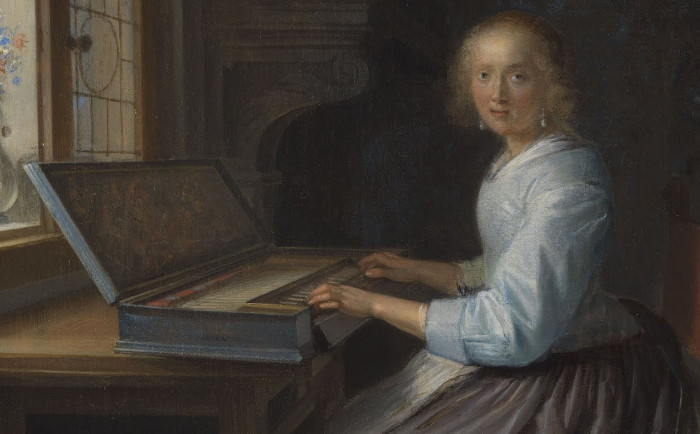
Gerrit Dou
c.1665
Oil on panel, 29.9 x 37.7 cm.
Dulwich Picture Gallery, London
In seventeenth-century Dutch, both virginals and clavichords were called clavecijn, clavesingel, or clavecimbael, which understandably leads to confusion. This explains the title of Vermeer's painting in Diego Duarte's collection, described as "a small painting with a lady playing the clavecin, with accessories." Of the thirty-five compositions by Vermeer, three virginals are represented: The Music Lesson (fig. 3), A Lady Seated at a Virginals (fig. 4) and A Lady Standing at a Virginal (fig. 5). The keyboard instrument in Vermeer's Concert is not a virginals but rather a harpsichord. The virginals of The Music Lesson was constructed by the Ruckers family. About one hundred are known to exist today (fig. 6).
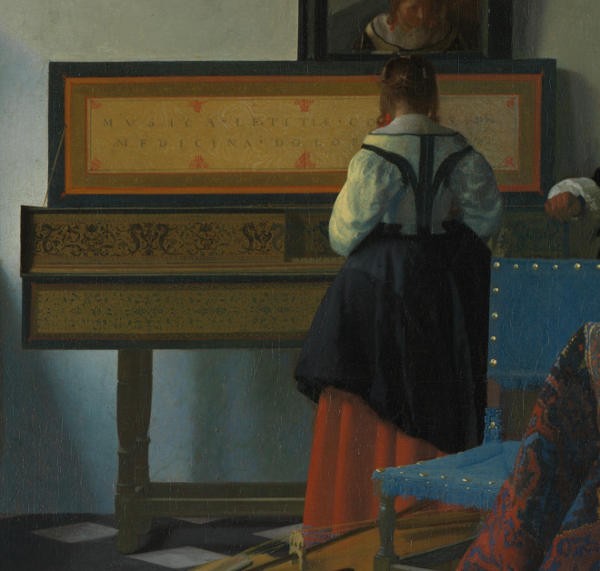
Johannes Vermeer
c. 1662–1665
Oil on canvas, 73.3 x 64.5 cm.
The Royal Collection, The Windsor Castle
The virginals in Vermeer's paintings are of the muselar type. Because the keyboard is fairly high up, it was not unusual to play standing; the seated position is not ergonomically sound, with her elbows lower than her hands, which cannot t be very comfortable. While the virginal and harpsichord are both keyboard instruments, they have distinct differences. Sound production varies between the two instruments. In the case of harpsichord, pressing a key causes strings to be plucked by quills or plectra, resulting in a bright sound. In contrast, virginals use quills that are attached to jacks for plucking the strings.. Additionally, harpsichords tend to be larger with horizontal strings, whereas virginals are smaller and feature a compact, rectangular shape with strings running parallel to the keyboard. Harpsichords are less portable because of their size, while virginals are more portable and easier to move. Historically, both instruments were popular during the Renaissance and Baroque periods, but harpsichords continued to evolve and remained in use through later eras, whereas virginals became less common as the harpsichord gained in popularity.
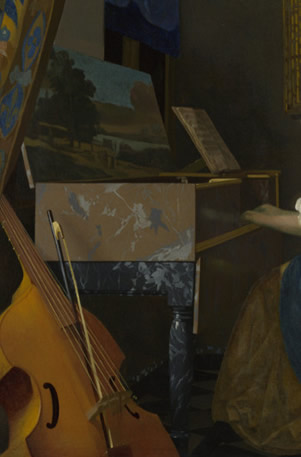
Johannes Vermeer
c. 1670–1675
Oil on canvas, 51.5 x 45.5 cm.
National Gallery, London
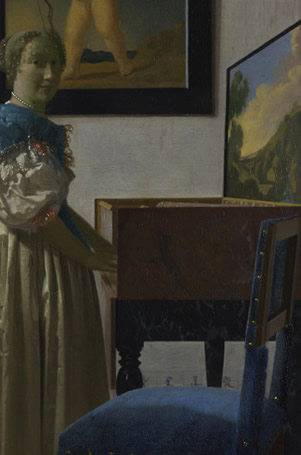
Johannes Vermeer
c. 1670–1674
Oil on canvas, 51.7 x 45.2 cm.
National Gallery, London
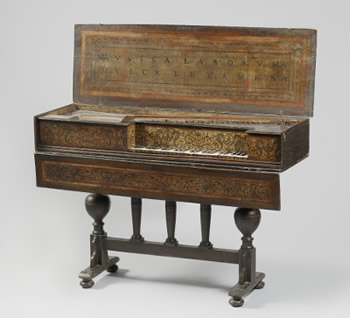
Johannes Ruckers (attributed to)
1640
Antwerp
Poplar, spruce, oak, bone, iron, brass and paper, 150.0 x 48.0 x 22.0 cm
l 106.0 cm × w 42.5 cm × h 78.0 cm
Koninklijk Oudheidkundig Genootschap, Amsterdam
Vermeer's virginals appear so authentically rendered that we can scarcely believe he did not paint them from model. However, such expensive instruments were surely out of his economic reach. Dutch music expert Edwin Buijsen Edwin Buijsen and Louis Peter Grijp, The Hoogsteder Exhibition of Music & Painting in the Golden Age (The Hague/Zwolle: Hoogsteder & Hoogsteder/Waanders, 1994). believes that they could have been seen at the home of the music lover Cornelis Graswinckel, who was related by marriage to Vermeer's patron Pieter van Ruijven. Nor is it impossible that on one occasion Vermeer traveled to nearby The Hague to admire the famous collection of musical instruments belonging to Constantijn Huygens (1596–1687). A study of a large sample of paintings from the Low Countries by Ton Koopman and Lucas van Dijk revealed that ninety percent of the keyboard players are women.
There are eseentially two types of virginals construction. In muselar virginals (fig. 7), or muselars, the keyboard is placed to the right, so that the strings are plucked in the middle of their sounding length. "The layout of a muselar, with keyboard towards the right-hand end of the case, gives the same kind of modification of timbre as a guitarist or cittern player plucking further from the bridge of his instrument, developed and enriched by the deep chest-like soundbox. From a rounded piping tone in the treble to a full but slow speaking and undefined bass timbre the muselar sounds so unlike an ordinary harpsichord that many on first hearing it do not associate it with that family of instruments. The idiosyncrasy of tone, articulation and damping make it unfit for very fast or very complex music, and its strong personality and distinct registers seem to suit an open-textured keyboard idiom of melody and an unelaborated bass best of all. In contrast, the spinet virginals have the keyboard on the left plucking close to the end of the string, the sound is more pointed and insistent. This is the more common arrangement, and an instrument described simply as a "virginal" is likely to be a spinet virginal.
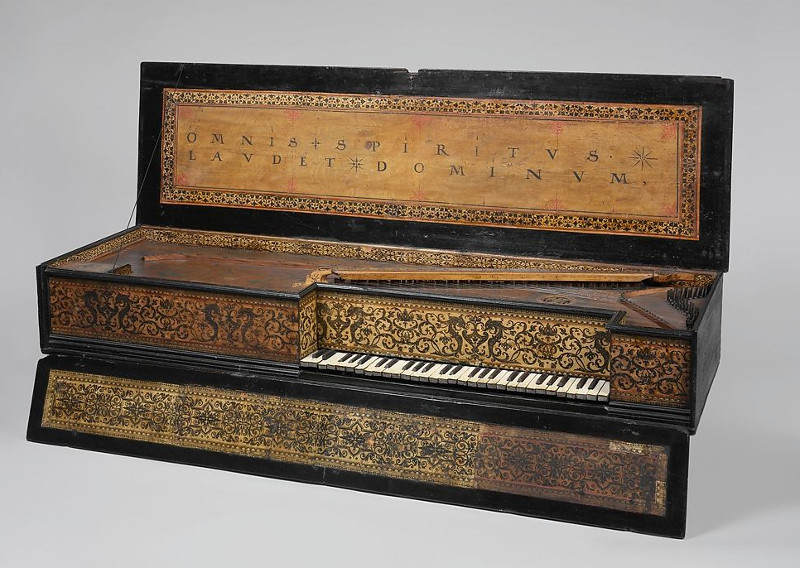
Joannes (Jan) Ruckers
1622
Wood, paint, bone, metal, beech, and leather, Height: 24 cm.
Width (parallel to keyboard): 170.8 cm.
Depth (perpendicular to keyboard): 48.8 cm.
Metropolitan Museum of Art, New York
The Netherlands, being a major hub of trade and commerce, played a crucial role in distributing finely crafted keyboard instruments across Europe, thereby exerting a considerable influence on instrument making in other countries. Virginals, which are smaller and simpler compared to harpsichords, found a special place in domestic settings, often adorned with intricate marquetry and paintings, especially on the insides of their lids.
The era was marked by significant innovation and improvement in instrument design, including enhancements in stringing and action mechanisms, as well as the overall size and shape of the instruments, leading to improvements in both sound quality and playability.
In the late sixteenth and early seventeenth centuries, muselar virginals were appreciated for their unique sound quality. In muselar virginals, the placing of the keyboard to the right enables the playing mechanism to create a rich and full sound by plucking the strings right in the middle of their sounding length but this positioning places the action for the left hand in the exact middle of the highly resonant soundboard. This occasionally results in inevitable clicks, faithfully amplified by the soundboard, which can occasionally make rapid left-hand scales somewhat problematic. In addition to mechanical noise, the central plucking point in the bass makes repetition difficult, because the motion of the still-sounding string interferes with the ability of the plectrum to connect again. A rather prejudiced eighteenth-century comment goes so far as to say that instruments "which have the keyboard on the right-hand side are good in the right hand, but grunt in the bass like young pigs."
Based in Antwerp, the Ruckers family was a true dynasty of virginals and harpsichord makers in the sixteenth and seventeenth century. The Ruckers contributed immeasurably to the technical development of existing keyboard instruments; their quality is such that the name of Ruckers is as important to early keyboard instruments as that of Stradivarius is to the violin family. Their instruments have always been valued for the beauty of their resonant, balanced tone—regarded as an ideal in most of Northern Europe—which was achieved through thoroughly masterful designs and excellent craftsmanship, still studied as a model by harpsichord makers today.
Under the influence of Joannes and Andreas Ruckers I, in the seventeenth century, the production of the virginl had reached its peak. Construction became conistent. Painted arabesques and lid paintings were replaced in many instances by block-printed papers, including the dolphin motif (fig. 8) that is represented in many paintings of the period. Studying the numbering systems found on surviving instruments, it has been estimated that the combined output of the Ruckers workshops in a forty-five year period is from three thousand and thirty-six hundred virginals and harpsichords.
Many of the patterns used by the Ruckers family were drawn from Renaissance pattern books printed expressly for the use of decorators, gold and silversmiths, embroiderers, lace-makers, etc.

Discovered in central Italy around the year 2000, the Accardi spinet occupies a unique place in musical heritage, as it is the only six-feet Ruckers virginals restored to its original sounding condition. It was built in the Antwerp workshop of the brothers Joannes and Andreas Ruckers. The date 1604 can be detected amidst the painted decoration on its soundboard. The original signature has been lost together with the jack rail and rose but, from the style of this painted decoration, it is certainly typical of the early period of the instruments signed by Joannes Ruckers. The keyboard has forty-five keys made of white bone and ebonized bone.